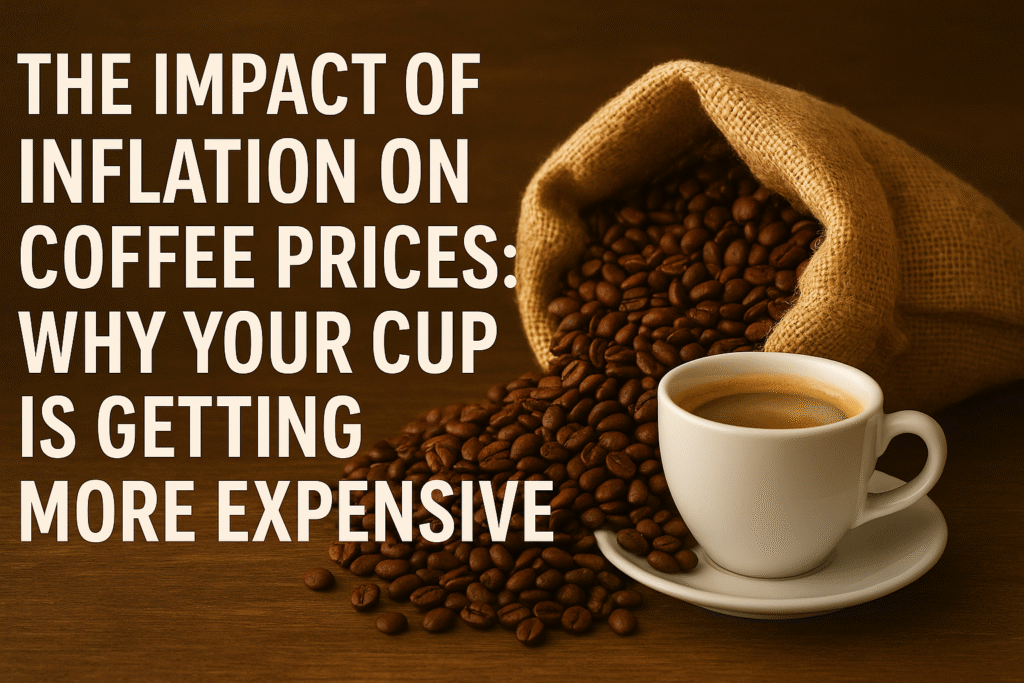Have you noticed that your favorite bag of coffee costs more than it did a year ago? Or maybe your daily latte has gone up by a few cents—or even a dollar. It’s not your imagination. Inflation is affecting nearly every corner of the global economy, and coffee—one of the most traded commodities in the world—is no exception. But what’s really driving these rising prices? And why is your daily cup of comfort suddenly feeling like a luxury?
Understanding the Coffee Supply Chain
Coffee doesn’t appear in your cup by magic. It’s the end product of a complex global supply chain involving farmers, exporters, importers, roasters, distributors, and retailers. When inflation impacts any part of this chain—whether it’s fuel costs, fertilizer prices, labor wages, or shipping fees—the effects ripple across the entire industry. Add in global economic slowdowns, supply shortages, and climate challenges, and you’ve got a perfect storm brewing inside your mug.
Inflation at the Source: Rising Costs for Coffee Farmers
For coffee producers, inflation has become one of their biggest challenges. Fertilizer costs have doubled in some regions, and essentials like machinery, transportation, and even storage sacks have become significantly more expensive. Many small-scale farmers in top coffee-producing countries—such as Brazil, Colombia, and Ethiopia—already operate with razor-thin profit margins. Now, rising input costs are pushing some to either reduce production quality or abandon coffee farming altogether.
This economic pressure affects not only farmers’ livelihoods but also the overall sustainability of the coffee industry. Without financial stability, growers can’t invest in better farming practices, new technologies, or climate adaptation strategies. This limits their ability to maintain both quality and yield in the long term.
Roasters and Cafés: Battling Higher Operating Costs
Inflation doesn’t stop at the farm. Roasters and coffee shops are also feeling the strain. Energy prices are soaring, freight costs for shipping containers remain high after the pandemic, and import tariffs are eating into profits. Even basic materials like cardboard packaging, coffee bags, and labels have increased in cost.
To stay competitive, many coffee businesses have had to make tough choices—such as raising menu prices, reducing portion sizes, or simplifying their offerings. On top of that, rising wages and operational expenses mean that running a coffee shop has never been more expensive. Despite these hurdles, many cafés are trying to maintain their commitment to quality and ethical sourcing, knowing that loyal customers value both transparency and taste.
Consumers Feel the Pinch
For coffee lovers, inflation often shows up in subtle ways: smaller bags, higher prices, or fewer premium options. A bag of specialty coffee that once cost $15 may now be $18 or more—not because the beans are better, but because everything else around them costs more.
While some consumers are willing to pay extra for traceable, ethically sourced beans, others are switching to cheaper blends or instant coffee to manage expenses. This shift in consumer behavior can have a domino effect on the entire industry, discouraging investment in high-quality and sustainable production.
How Inflation Threatens Coffee Quality and Innovation
The impact of inflation on coffee prices goes far beyond simple economics. When farmers can’t afford to invest in modern equipment, drying infrastructure, or disease-resistant coffee plants, the overall quality and diversity of coffee suffer. If these challenges persist, the industry could face a decline in innovation and environmental resilience, affecting everything from flavor profiles to the availability of certain coffee varieties.
Inflation also amplifies existing inequalities in the coffee trade. Smaller farmers, who lack access to financial support or direct export opportunities, are often the most vulnerable. Without intervention, these producers risk being pushed out of the market entirely—leaving only large-scale operations that can absorb higher costs.
Solutions Brewing: How the Industry Can Respond
Despite the challenges, there are ways to cushion the effects of inflation on coffee prices. Some promising initiatives include:
1. Direct Trade and Long-Term Contracts
By establishing direct relationships between coffee producers and roasters, farmers can secure fair and stable prices that protect them from volatile market swings. Long-term contracts also encourage sustainable farming practices and foster mutual trust across the supply chain.
2. Investment in Local Infrastructure
Building local processing facilities and distribution networks helps reduce dependency on imports and lowers transportation costs. This approach strengthens regional economies and keeps more profits within coffee-growing communities.
3. Transparency Across the Supply Chain
When consumers understand the real costs behind their cup of coffee, they’re more likely to support fair pricing. Transparency—from farm to cup—builds awareness and encourages people to pay a fair price that reflects the effort and value behind every bean.
The Human Side of Inflation in Coffee
At its core, the story of inflation in coffee isn’t just about numbers—it’s about people. It’s about the farmer battling rising temperatures and higher fertilizer costs. The exporter struggling to find affordable shipping options. The barista explaining why your cappuccino now costs a bit more. Each stage of the coffee journey is deeply connected, and when inflation hits, everyone feels it.
Your cup of coffee is more than just a drink—it’s a global collaboration shaped by economics, climate, and human effort. Understanding that connection helps us appreciate the real value of coffee beyond the price tag.
A Thoughtful Sip: Why Paying More Can Mean Doing Better
Yes, inflation has made coffee more expensive. But behind that price increase lies a story of resilience and adaptation. Supporting ethical coffee brands, choosing direct-trade roasters, and being willing to pay fair prices are small but powerful ways to make a difference.
Every sip you take supports a global network of people who work hard to bring that flavor to your cup. In a time of rising costs, choosing fair, sustainable coffee isn’t just about taste—it’s a conscious act of awareness and solidarity.
